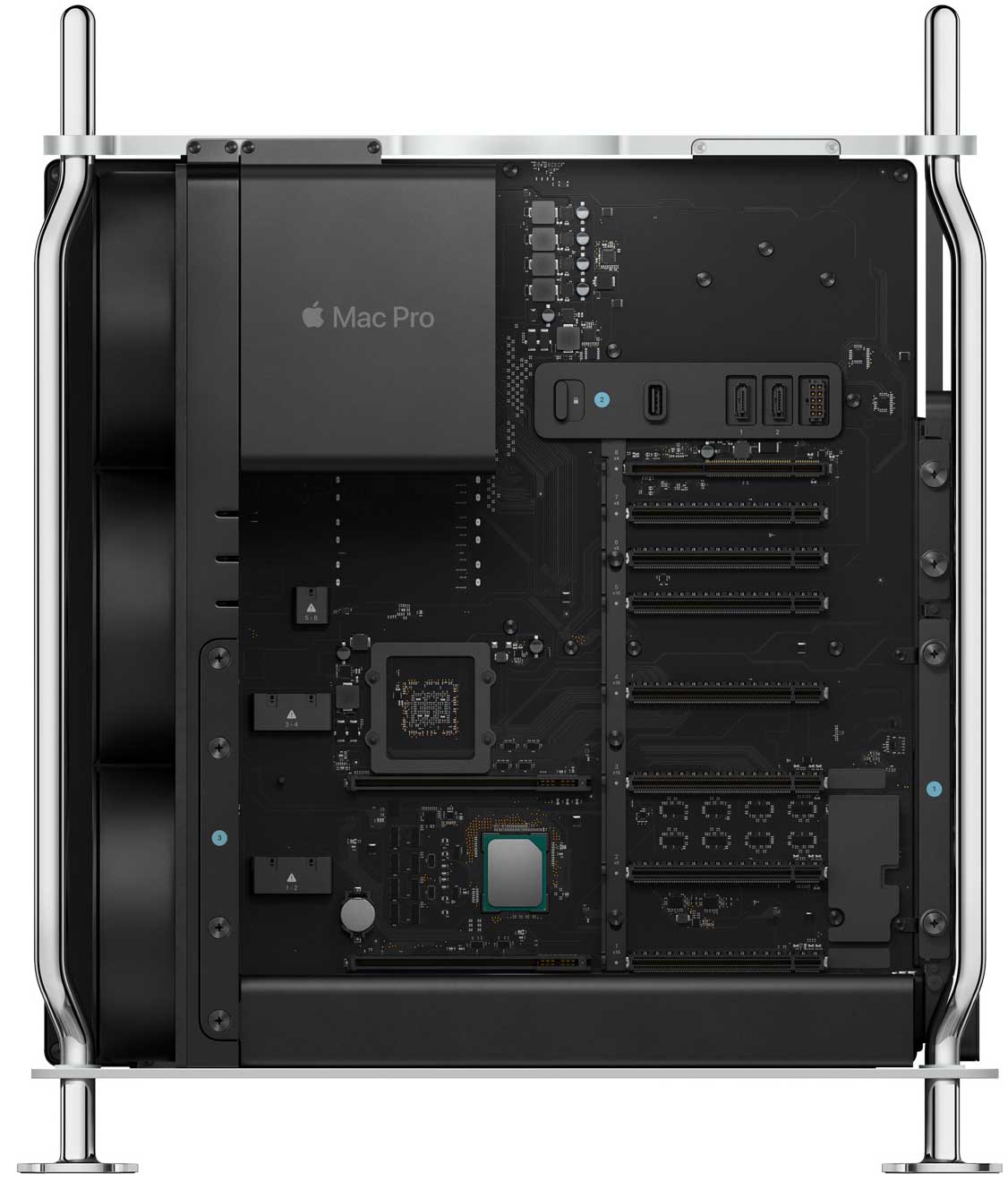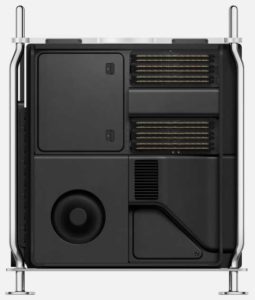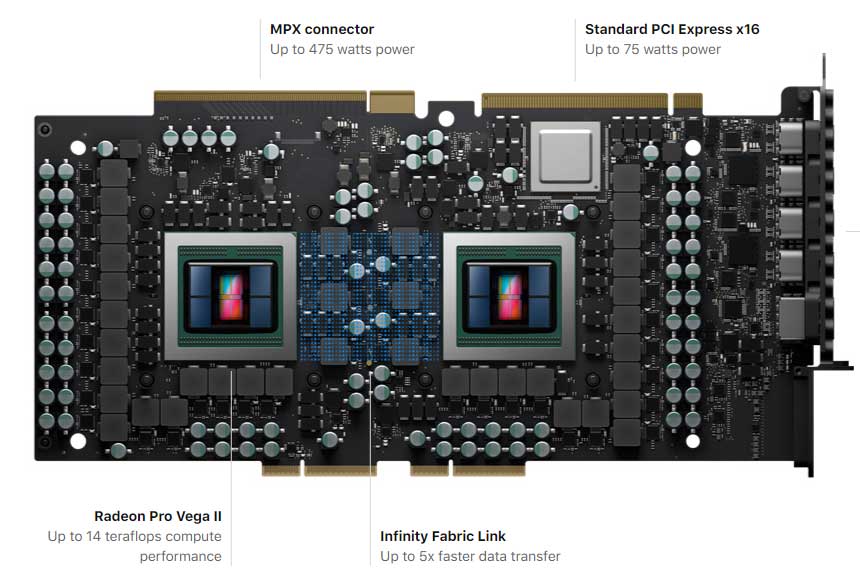It has been 7 years since Apple released a computer with PCIe slots, and therefore the ability to customize or upgrade core components, like the GPU, which is half of a modern workstation. With this month’s release of the Mac Pro, Apple is once again in the business of supplying its users with powerful computers. While the Mac Pro isn’t necessarily faster than the options that have been available to Windows users for the past few years, it is much faster than anything Apple has ever sold. And it scales higher than anything Apple has ever built as well. Both the minimum and maximum price for the Mac Pro exceeds anything Apple has ever offered, including their previous server line.
 This is less a function of Apple’s innovation, and more a reflection of changes in the market that have been unnoticed by users who only look at notebooks and all in one systems, even for professional work. The price of a consumer CPU has remained $100-$500 as they have gotten marginally faster. But professional CPUs have increased exponentially in both price and performance in the same time period. AMD has brought the price down significantly, while still maintaining that maximum potential performance, but CPU’s with high core counts can still maintain high frequencies as well, making them worth the thousands of dollars they cost, for highly threaded tasks that can utilize their potential.
This is less a function of Apple’s innovation, and more a reflection of changes in the market that have been unnoticed by users who only look at notebooks and all in one systems, even for professional work. The price of a consumer CPU has remained $100-$500 as they have gotten marginally faster. But professional CPUs have increased exponentially in both price and performance in the same time period. AMD has brought the price down significantly, while still maintaining that maximum potential performance, but CPU’s with high core counts can still maintain high frequencies as well, making them worth the thousands of dollars they cost, for highly threaded tasks that can utilize their potential.
So the sticker shock for the minimum price is a result of Apple’s marketing decisions, but the maximum prices is due to the level of scalability available in Intel’s chipsets and CPUs. Supporting up to 1.5TB RAM is a technological feat that few users will be able to afford or effectively utilize. 28 Xeon cores are more likely to be used on occasion, as software becomes more optimized for high core count CPUs.
 I was initially surprised to see that Apple based their new top end Mac Pro on a single socket architecture, but it makes sense, because most users, even on PCs, who used to need a dual socket system, can now accomplish the same tasks just as well on a single socket system, whether they realize it or not. Single socket systems scale far higher than they used to, and there are still options above there. Everyone is marveling at how powerful the new Mac Pro can be, while PC users have had both this level of performance, and another option beyond that tier, this whole time, and will continue to, if needed. Apple of course also has the option of creating an even higher tier system in the future, based on dual socket scalable Xeon processors (or AMD EPYC chips) but I doubt they will anytime soon. The Mac Pro is making its desired splash, and introducing something even more powerful within a year or two would waste the position they currently have, for a tiny potential market that they have ignored for many years, who probably no longer use OSX for that reason.
I was initially surprised to see that Apple based their new top end Mac Pro on a single socket architecture, but it makes sense, because most users, even on PCs, who used to need a dual socket system, can now accomplish the same tasks just as well on a single socket system, whether they realize it or not. Single socket systems scale far higher than they used to, and there are still options above there. Everyone is marveling at how powerful the new Mac Pro can be, while PC users have had both this level of performance, and another option beyond that tier, this whole time, and will continue to, if needed. Apple of course also has the option of creating an even higher tier system in the future, based on dual socket scalable Xeon processors (or AMD EPYC chips) but I doubt they will anytime soon. The Mac Pro is making its desired splash, and introducing something even more powerful within a year or two would waste the position they currently have, for a tiny potential market that they have ignored for many years, who probably no longer use OSX for that reason.
 The system of course has all SSD based storage in dual M.2 slots, that claim 3.4GB/sec of bandwidth for both read and write, maxing out the PCIe Gen3 bus. It also has dual 10GBase-T ports, which PCs need to get more onboard with. It has Thunderbolt 3 and USB3 available on a separate I/O card, which will probably allow for future upgrades to USB4 and such. With 6 channels of RAM across 12 slots, users should definitely opt for at least 48GB for maximum bandwidth.
The system of course has all SSD based storage in dual M.2 slots, that claim 3.4GB/sec of bandwidth for both read and write, maxing out the PCIe Gen3 bus. It also has dual 10GBase-T ports, which PCs need to get more onboard with. It has Thunderbolt 3 and USB3 available on a separate I/O card, which will probably allow for future upgrades to USB4 and such. With 6 channels of RAM across 12 slots, users should definitely opt for at least 48GB for maximum bandwidth.
Where things get really interesting is when we look at the video offerings. Their new MPX modules integrate PCIe, Thunderbolt, and power into an auxiliary slot for cleaner systems. They have all new GPU options, exclusively from AMD, which make it hard to compare them to PC options. This is similar to when G5 CPUs were difficult to compare to Intel based Windows systems, because there was no apples to apples options to compare. But their top end cards have dual GPU chips on each card, for a maximum of 4 GPUs on two MPX modules.
 This relates to the ongoing issue of the lack of CUDA support in OSX, and their exclusivity to AMD GPUs they push their Metal graphics API on their software partners. I have always had good results with CUDA products, and it used to be cross-platform, leading to better software than was more consistent and probably cheaper to make. By forcing OSX developers to use Metal to accomplish tasks they are doing with CUDA on PC, Apple is making it harder to develop cross platform applications, and we are more likely to lose feature parity in those applications. This hurts users on both sides, especially in industries that Apple targets its high performance products towards, like film production. Oil and gas users are probably all PC based, so they are unaffected by Apple’s decisions, but even with an all PC facility, I am affected by it when I need to collaborate with other users, whose software is less likely to interface smoothly with mine. And CUDA has a ten year head start in the software development world, so it will take a while for Metal to develop that level of ecosystem maturity. I am just happy I am on PC, running CUDA accelerated programs on my NVidia cards. Windows isn’t making me very happy these days, but primarily because it is becoming more like OSX, removing user control.
This relates to the ongoing issue of the lack of CUDA support in OSX, and their exclusivity to AMD GPUs they push their Metal graphics API on their software partners. I have always had good results with CUDA products, and it used to be cross-platform, leading to better software than was more consistent and probably cheaper to make. By forcing OSX developers to use Metal to accomplish tasks they are doing with CUDA on PC, Apple is making it harder to develop cross platform applications, and we are more likely to lose feature parity in those applications. This hurts users on both sides, especially in industries that Apple targets its high performance products towards, like film production. Oil and gas users are probably all PC based, so they are unaffected by Apple’s decisions, but even with an all PC facility, I am affected by it when I need to collaborate with other users, whose software is less likely to interface smoothly with mine. And CUDA has a ten year head start in the software development world, so it will take a while for Metal to develop that level of ecosystem maturity. I am just happy I am on PC, running CUDA accelerated programs on my NVidia cards. Windows isn’t making me very happy these days, but primarily because it is becoming more like OSX, removing user control.
 The other video card offering that stands out is Apple’s new Afterburner card, for accelerating ProRes playback. They claim that the $2000 card can playback 6 streams of 8K RAW video, which is an impressive amount of data. $2000 could buy another whole (non-Mac) system, so that price seems high until you compare it to the Red-RocketX which used to retail for $7000, and did two streams of 6K, if I recall correctly. And I would imagine that the acceleration is implemented at the codec decode level, so it should accelerate any application playing back ProRes files, but I have no way to confirm that. But it seems like anyone using the Mac Pro to edit high resolution ProRes files would want to consider adding the Afterburner card.
The other video card offering that stands out is Apple’s new Afterburner card, for accelerating ProRes playback. They claim that the $2000 card can playback 6 streams of 8K RAW video, which is an impressive amount of data. $2000 could buy another whole (non-Mac) system, so that price seems high until you compare it to the Red-RocketX which used to retail for $7000, and did two streams of 6K, if I recall correctly. And I would imagine that the acceleration is implemented at the codec decode level, so it should accelerate any application playing back ProRes files, but I have no way to confirm that. But it seems like anyone using the Mac Pro to edit high resolution ProRes files would want to consider adding the Afterburner card.
 With all of this video horsepower, it makes sense that Apple would also release a monitor to pair with their new desktop. I am a bit surprised at the high price tag on their $6000 Pro Display XDR, but I suppose there are generic options for their lower budget users. 32″ is the right size for a premium user, and at the 218 DPI that they are used to from the iMac Pro and Retina displays, 6K resolution does make sense. True HDR requires zoned back-light control, which is provided by 576 separate LED back-lights, which is how we start seeing where the price is coming from. The 6016×3384 resolution is a bit of a mystery to me, as it won’t display true 6K (6144 pixels wide ) content without scaling, but as a UI display, you can watch 4K content in all of its glory while still having tools available on screen if desired. I love my 8K Dell monitor, and this is only slightly lower res than that, so people who fork over the cash will love using this display. I am excited for what I expect it to do to the HDR display market. If it is successful, other options will emerge, which will lower the price, and encourage better HDR software support on PCs as well.
With all of this video horsepower, it makes sense that Apple would also release a monitor to pair with their new desktop. I am a bit surprised at the high price tag on their $6000 Pro Display XDR, but I suppose there are generic options for their lower budget users. 32″ is the right size for a premium user, and at the 218 DPI that they are used to from the iMac Pro and Retina displays, 6K resolution does make sense. True HDR requires zoned back-light control, which is provided by 576 separate LED back-lights, which is how we start seeing where the price is coming from. The 6016×3384 resolution is a bit of a mystery to me, as it won’t display true 6K (6144 pixels wide ) content without scaling, but as a UI display, you can watch 4K content in all of its glory while still having tools available on screen if desired. I love my 8K Dell monitor, and this is only slightly lower res than that, so people who fork over the cash will love using this display. I am excited for what I expect it to do to the HDR display market. If it is successful, other options will emerge, which will lower the price, and encourage better HDR software support on PCs as well.
Now how does all of this stack up against current PCs that are available? I spec’ed out an HP Z4 single socket system as closely as I could to the $8K 16-Core Mac Pro option, and came up with a retail price of $4600. So you are paying a lot more for the Mac Pro, but have the potential for more RAM capacity and bandwidth, more PCIe slots, and a flashy system that should run quieter, if their advertising is to be believed.
As for me and my company, we will stick with PCs. But I can no longer accurately say that my system can run circles around any Mac system. And regardless of the price, Apple will sell these Mac Pro’s as fast as they can make them. Anyone who still has been limping along an old Mac tower is an immediate customer, and most trash can users will be ready for them pretty soon as well. Every Pro-tools room, and Avid bay in Hollywood that hasn’t switched to Windows by now will have them under the desk within two years. And rightfully so, Apple has finally released a powerful system that their users have been requesting for many years.

